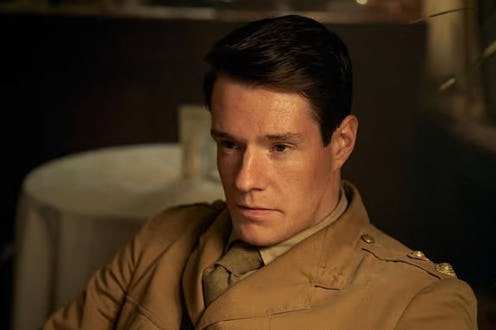TV & Movies
The Real David Stirling Escaped Capture Five Times In A Row
SAS Rogue Heroes merely covers the beginning of The Phantom Major’s story.

The latest BBC historical drama series SAS Rogue Heroes already has a lot of us talking, especially when it came *that* finale. And when a series is based on real characters and events, the intrigue is amped up to a whole new level. Based on Ben Macintyre’s book of the same name, the series centres around David Stirling, who founded the Special Air Service during World War II. Portrayed by Connor Swindells of Sex Education fame, the character is one audiences were quickly drawn to. But who exactly was Sir David Stirling in real life?
Born in 1915 in Perthshire, central Scotland, Archibald David Stirling was the son of Brigadier-General Archibald Stirling, and Margaret Fraser, whose father was the Lord Lovat Simon Fraser. He attended a year at Trinity College, Cambridge, before heading off to Paris to become an artist. But he wasn’t just interested in art and had quite a wide range of interests, which included training to climb Mount Everest when WWII broke out.
During the war, Stirling was commissioned into the Scots Guards, later volunteering to join an ad-hoc military formation nicknamed Layforce. The team was disbanded after suffering heavy casualties, but this was where Stirling became convinced that a small team of highly-trained soldiers working with the element of surprise could attack several targets in a single night. And this idea became the basis for the SAS.
Instead of navigating the red tape and chain of command, Stirling snuck into the military headquarters in Cairo to meet directly with Commander-in-Chief General Sir Claude Auchinleck, where he encountered the deputy chief of staff, Major General Neil Ritchie. Ritchie proved to be the turning point in Stirling’s career. Impressed with Stirling’s innovation and daring, he persuaded Auchinleck to approve a new special operations unit, named ‘L Detachment, Special Air Service Brigade’ to deliberately mislead people into thinking it was a parachute brigade.
After a rocky start and a bungled attempt at attacking a German airfield, Stirling decided that the SAS would operate best on land, under cover of night. Under his command, they adapted Jeeps with machine guns, and invented the first handheld dual explosive and incendiary device, the Lewes bomb — named for SAS founding principal training officer John Steel “Jock” Lewes (portrayed by Alfie Allen in SAS Rogue Heroes).
Stirling’s prowess at hit-and-run airfield raids caused German field marshal Erwin Rommel to dub him “The Phantom Major.” In January 1943, Stirling was captured by the Germans, and escaped only to be recaptured by the Italians. He escaped another four times before being sent to Colditz Castle, where he remained for the remainder of the war. After Stirling’s capture, Paddy Mayne (portrayed by Jack O’Connell) took over command of the SAS.
After the war, Stirling kept himself busy. He outsourced British weapons and military personnel to other countries; gathered ex-military contacts and former SAS members to form the Great Britain 75, which planned to take over government operations in the event of civil unrest, before his plans were outed and consequently abandoned. Stirling also founded the Capricorn Africa Society in his later years, to promote an Africa free from racial discrimination.
Stirling was awarded the Distinguished Service Order in 1942, granted the honorary rank of lieutenant-colonel in 1947, and was later appointed a Knight Bachelor in the 1990 New Year Honours for services to the military. He died that same year, aged 74, and the current Laird of Stirling’s ancestral estate at Keir is his nephew Archie Stirling, a businessman and former Scots Guards officer.
SAS Rogue Heroes is now available to stream on BBC iPlayer.